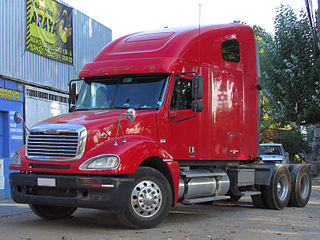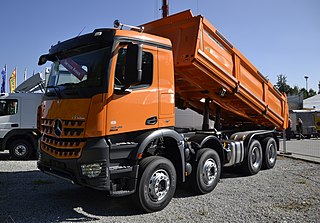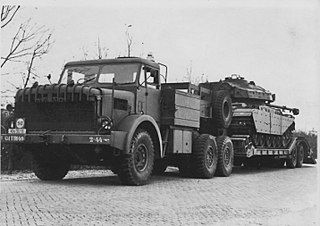
The Thornycroft Hathi (Hindi: "elephant") [1] was an early four wheel drive lorry built by Thornycroft in the 1920s. It was used by the British Army as an artillery tractor.

The Thornycroft Hathi (Hindi: "elephant") [1] was an early four wheel drive lorry built by Thornycroft in the 1920s. It was used by the British Army as an artillery tractor.
There was a lack of British-developed four-wheel-drive vehicles developed during the First World War and no commercial demand for them afterwards. As a result, the British Army, under the time's general assumption of indigenous sourcing, was forced to develop its own vehicle. [2] The Hathi prototype was developed in 1922 [3] by a team of P Company under Professor (honorary Colonel) Herbert Niblett DSO of the Royal Army Service Corps' Training College at Aldershot, [4] using parts of a German Erhardt tractor. [5] [6] Production models were built by Thornycroft, 25 being built in 1924. Niblett was Sir John Isaac Thornycroft's son-in-law. [7]
Although capable for its day, the Hathi was a complex and expensive vehicle that required regular maintenance if the front axle was to remain reliable. For most purposes it was soon replaced by 6×4 lorries with just as many driven wheels, but without the need for the complex combined driving and steering axle. Even half-tracks, particularly the Kégresse system, were more popular in this period.[ citation needed ]
The first vehicle was built as an experimental prototype, but its success was so great that plans were made to produce them commercially. The specification of requirements was thus drawn up in October 1923, after the prototype had been trialled. [3] These were:

The bodywork of the Hathi was typical for the time with a wide bench seated open cab and no windscreen. The only weather protection was a folding canvas roof. Although the lack of cab was typical for the time, it had also been part of the requirement to maintain a low profile.
As with other Thornycroft vehicles the radiator surround was a massive casting (in aluminium, to save weight) topped by a brass header tank with the "Thornycroft" name prominently cast into it. A distinctive feature of the Hathi, appropriately giving its elephantine appearance, was the extreme width of the bonnet. The top panels of the bonnet cover were also noticeably concave and are recognisable in photos.
Prominent spare wheels were mounted high up, on each side of the rear bodywork.
The engine was a Thornycroft GB6 11.3 litre straight-six petrol engine. [3] As was common for the period, the cylinders were cast in two blocks of three. The valve arrangement was inlet over exhaust, with inlet valves in the cylinder head and side-valves in the cylinder block for the exhaust. Dry sump lubrication was used, to avoid problems when tilted off-road. [8] [9] To reduce weight, many cast components were in aluminium, rather than iron.
Four wheel drive for heavy vehicles in this period was difficult and the Hathi used a complex arrangement of bevel gears to transmit drive through the steering joints of the front axle. [10] Rather than the now–common system of articulated drive shafts to the front hubs (the shaft either inside an axle casing or external), fixed shafts were used. Shafts inside the axle casing carried power to the ends of the axle, then a bevel gear drove a short vertical shaft running through the steering kingpin. A further bevel on the outer part of the hub carrier (the part moving with the steering) drove the hub itself.
The constant velocity joint used to make modern articulated drive shafts was unheard of as yet and even the simpler Hooke-type universal joint wasn't yet in common use. Thornycroft's usual practice for prop shafts at the time was to use a flexible leather disk joint. [10] To save weight, the axle casings were cast in aluminium.
Production Hathi used single steel disk wheels with 8 studs. The tyres were narrow by modern standards for an off-road vehicle and did not have the exaggerated tread pattern now common, or the bar grip pattern used during the WWII period.
To provide a greater grip, typical experiments for the period were carried out, with double wheels and tyres fitted and with cleated tyre chains over these. [3] The doubled wheels used a different wheel from standard, with a greater offset.
The Hathi introduced a number of innovations that would become standard on military tractors in later years, including the Scammells.
The rear towing draw-bar consisted of a multiple-leaf horizontal leaf spring, spanning the rear chassis rails. This coupled the towing forces directly into the chassis, but also allowed jolts to be cushioned. [3]
When winching, the Hathi was fitted with chassis-mounted scotches that hinged down to hold the vehicle in place against the ground. These were stronger than chocking the wheels, quicker to deploy and also carried the winching forces directly into the chassis, rather than through the suspension. [3] These were an innovation of the production Hathi, the prototype vehicle instead having used a precarious arrangement of wheel ramps that lifted the rear of the vehicle off the ground. [11]
A single 6×6 Hathi was produced as an experiment. [12] [13] This was a new build vehicle, with a redesigned chassis. Once again, this was produced by P Company of the RASC Experimental Department. It was tested by the MWEE in May 1928. Double wheels were used with optional chains. As would later be used on other 6×4 vehicles, the single rear chains spanned both axles.
Although successful in its trials, the 6×6 bogie suspension was the victim of its own success. The WD's development of its patented rear bogie suspension allowed 6×4 vehicles to be built on a commercial chassis, avoiding the complexity of the Hathi's driven front axle. Such vehicles had almost as good cross-country performance as the all-wheel-drive 6×6, but at lower cost and with the use of mass production commercial lorry factories, not military vehicle specialists. [13]
The Royal Marines also tested a single example of a half-track Hathi conversion, using tracks by the Roadless company. This was a relatively simple conversion, a Roadless speciality, using the existing rear axle of the Hathi as a combined drive sprocket and road wheel, with a two-wheel bogie and roadwheel idler ahead of this. [14]
Initial production was as an artillery tractor, as at this time the RASC supplied transport to the Royal Field Artillery. Very few Hathi were built, possibly just the original batch of 25. It was used with artillery such as the QF 3-inch 20 cwt anti-aircraft gun. [15]
In 1926, at least one Hathi was converted as a breakdown recovery vehicle. A fixed jib with a small hand-operated winch was mounted on the rear deck, with the frame for a canvas tilt over it. [5] Other examples were converted for the Royal Air Force and the Royal Navy, a naval example from Portsmouth Dockyard being the survivor today. [8]
Eight Hathi gun tractors were procured in 1925 along with five light trucks as part of token move towards mechanisation; Harry Chauvel, Inspector General and 1st Chief of the General Staff of the Australian Army proclaiming that "mechanization has been effected". [16] They were being used in the early 1930s in Northern Australia. [17]
Hathi were still in reserve service in Australia in 1945. [18]
A single example survives today, in the collection of the REME Museum - although it is not on regular display. [8] [19] [20]

A semi-trailer truck, also known as a semitruck, is the combination of a tractor unit and one or more semi-trailers to carry freight. A semi-trailer attaches to the tractor with a type of hitch called a fifth wheel.

A traction engine is a steam-powered tractor used to move heavy loads on roads, plough ground or to provide power at a chosen location. The name derives from the Latin tractus, meaning 'drawn', since the prime function of any traction engine is to draw a load behind it. They are sometimes called road locomotives to distinguish them from railway locomotives – that is, steam engines that run on rails.

In automotive design, a front-engine, front-wheel-drive (FWD) layout, or FF layout, places both the internal combustion engine and driven roadwheels at the front of the vehicle.

A dump truck, known also as a dumping truck, dump trailer, dumper trailer, dump lorry or dumper lorry or a dumper for short, is used for transporting materials for construction as well as coal. A typical dump truck is equipped with an open-box bed, which is hinged at the rear and equipped with hydraulic rams to lift the front, allowing the material in the bed to be deposited ("dumped") on the ground behind the truck at the site of delivery. In the UK, Australia, South Africa and India the term applies to off-road construction plants only and the road vehicle is known as a tip lorry, tipper lorry, tipper truck, tip truck, tip trailer or tipper trailer or simply a tipper.

A tow truck is a truck used to move disabled, improperly parked, impounded, or otherwise indisposed motor vehicles. This may involve recovering a vehicle damaged in an accident, returning one to a drivable surface in a mishap or inclement weather, or towing or transporting one via flatbed to a repair shop or other location.

The Mighty Antar was a heavy-duty 6×4 tractor unit built by Thornycroft from the late 1940s onwards. For some decades it was the standard tank transporter of the British Army and was also used by other nations. It was powered by a shortened V8 land version of the V12 Meteor engine, derived from the Merlin and modified to run on diesel, known as the Rolls-Royce Meteorite.

Thornycroft was an English vehicle manufacturer which built coaches, buses, and trucks from 1896 until 1977.
Scammell Lorries Limited was a British manufacturer of trucks, particularly specialist and military off-highway vehicles, between 1921 and 1988.

The Morris Commercial C8 FAT, commonly known as a Quad, is an artillery tractor used by the British and Commonwealth forces during the Second World War. It was used to tow field artillery pieces, such as the 25-pounder gun-howitzer, and anti-tank guns, such as the 17-pounder.

Six-wheel drive is an all-wheel drive drivetrain configuration of three axles with at least two wheels on each axle capable of being driven simultaneously by the vehicle's engine. Unlike four-wheel drive drivetrains, the configuration is largely confined to heavy-duty off-road and military vehicles, such as all-terrain vehicles, armored vehicles, and prime movers.

A tractor unit is a characteristically heavy-duty towing engine that provides motive power for hauling a towed or trailered load. These fall into two categories: heavy- and medium-duty military and commercial rear-wheel-drive semi-tractors used for hauling semi-trailers, and very heavy-duty typically off-road-capable, often 6×6, military and commercial tractor units, including ballast tractors.

A semi-trailer is a trailer without a front axle. In the United States, the term is also used to refer to the combination of a truck and a semi-trailer; a tractor-trailer.

The Meillerwagen was a German World War II trailer used to transport a V-2 rocket from the 'transloading point' of the Technical Troop Area to the launching point, to erect the missile on the Brennstand, and to act as the service gantry for fuelling and launch preparation.

The TatraT813 was a truck produced in Czechoslovakia by the Tatra company. It was produced from 1967 to 1982. The basic representative of this series was a military version of the 8×8 Kolos (Colossus), which was able to pull trailers up to a total weight of 100 tons. Tatra also produced a civilian version in either 6×6 or 4×4. After fifteen years of production, 11,751 vehicles were built in all modifications. Many units were exported to the USSR, East Germany, Romania and India.

An articulated hauler, articulated dump truck (ADT), or sometimes a dump hauler, is a very large heavy-duty type of dump truck used to transport loads over rough terrain, and occasionally on public roads. The vehicle usually has all-wheel drive and consists of two basic units: the front section, generally called the tractor, and the rear section that contains the dump body, called the hauler or trailer section. Steering is made by pivoting the front in relation to the back by hydraulic rams. This way, all wheels follow the same path, making it an excellent off-road vehicle.

A tank transporter is a combination of a heavy tractor unit and a mating full trailer or semi-trailer, used for transporting tanks and other armoured fighting vehicles. Some also function as tank recovery vehicles, the tractors of which may be armoured for protection in combat conditions.

The Bison was an extemporised armoured fighting vehicle frequently characterised as a mobile pillbox. Bisons were produced in Britain during the invasion crisis of 1940-1941. Based on a number of different lorry chassis, it featured a fighting compartment protected by a layer of concrete. Bisons were used by the Royal Air Force (RAF) to protect aerodromes and by the Home Guard. They acquired the generic name "Bison" from their main manufacturer.

The AEC Militant was a post-war development by AEC of the AEC Matador artillery tractor used during World War II. Externally the most noticeable development was the cab, which was considerably enlarged. Unlike the Matador only six-wheel versions were produced. Four-wheel versions are extant, but they are probably conversions and one is a Matador with a Mk1 Militant cab. Other changes included the fitting of a larger, 11.3-litre 6-cylinder, diesel engine and the use of a steel frame for the cab, rather than the ash (fraxinus) wood frame of the Matador. The Militant Mark 1 was produced in 6x4 and 6x6 form.
Driveline windup is also known as "axle binding" or "driveline binding".

An H-drive drivetrain is a system used for heavy off-road vehicles with 6×6 or 8×8 drive to supply power to each wheel station.